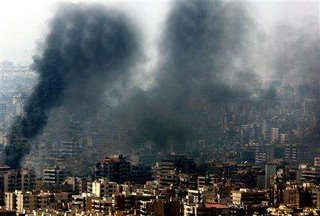

Johnson's analysis found that the smoke and the buildings were duplicated and enhanced to:
- make it appear that the smoke was darker that it really was
- that there were two fires instead of one
- that the area which was struck was more dense than in reality
Reuters pulls all of Hajj's 920 photos from the database as another photo was found to have been doctored.

Powerline makes a good point:
I'm not sure what the implications of removal from Reuters' database are, but if it means they will no longer be available for study on the web, it's a bad thing. (At the moment, they are still up on Yahoo News Photos.) The biggest problem with Hajj's pictures, in my opinion, is not that a couple of them were faked.
It's important to distinguish between "faking" and "staging." Reuters terminated its relationship with Hajj because two pictures were faked, i.e., digitally altered. It may well be that those are the only faked photos that Hajj submitted to Reuters. But, in my opinion, a great many of his pictures were staged, and, in my judgment, that is the more significant offense.
Hajj, it should be noted, submitted some famous photos of a dead child in Qana which certainly looks like its been staged.
Surely, though, this is just deceit or greed from one stringer. And can't reflect on the brave photojournalists who put their lives on the line to tell the story of Lebanon.
Um, actually it does. Here's an example of more fakery.
No comments:
Post a Comment